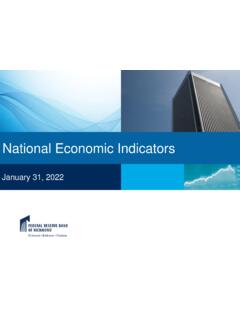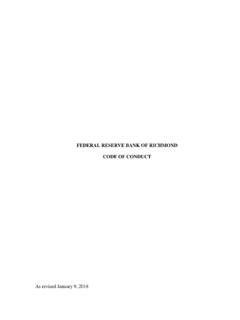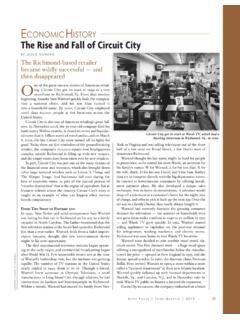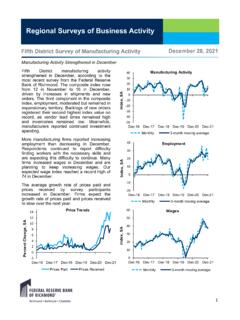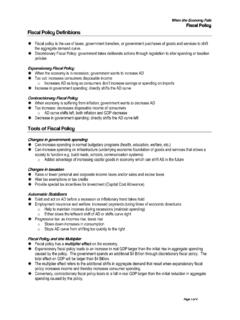Transcription of Monetary Policy in the 2008-2008 Recession
1 Economic Quarterly Volume 95, Number 2 Spring 2009 Pages 201 233 Monetary Policy in the2008 2009 RecessionRobert L. HetzelPowerful real shocks combined to buffet the economy in 2007 and combination of a fall in housing wealth from declining house pricesand a fall in real income from increasing energy and food prices madeindividuals worse off. Although a moderate Recession began at the end of 2007,it intensified in the summer of 2008 . Based on the view that dysfunctionin credit markets intensified the Recession , Monetary Policy has focused onintervention into individual credit markets deemed alternative explanation offered here for the intensification of the reces-sion emphasizes propagation of the original real shocks through contractionarymonetary Policy .
2 The intensification of the Recession followed the pattern ofrecessions in the stop-go period of the late 1960s and 1970s, in which the Fedintroduced cyclical inertia in the funds relative to changes in economic activ-ity. For example, in late 1973 and early 1974, an inflation shock because of anoil-price rise and the end of price controls reduced real income. The recessionthat began in November 1973 intensified in the late fall of 1974. In the summerof 1974, the Fed backed away from its procedures calling for reductions inthe funds rate in response to deteriorating economic activity (Hetzel 2008a,Ch.)
3 10). However, with a funds rate that peaked in July 1974 at 13 percent,the Fed eventually had ample room to lower significantly the nominal and realfunds rate. What is unusual about the current period is the zero-lower-bound(ZLB) constraint that arises with a zero-funds argument advanced here is that in the summer of 2008 the FederalOpen Market Committee s (FOMC) departure from its standard proceduresThe author is a senior economist and research advisor at the Federal Reserve Bank ofRichmond. The author received helpful criticism from Michael Dotsey, Marvin Goodfriend,Marianna Kudlyak, Yash Mehra, Ann Marie Meulendyke, Motoo Haruta, John Walter, RoyWebb, John Wood, Leland Yeager, and participants at the Rutgers History Workshop includingMichael Bordo, Hugh Rockoff, John Weinberg, Eugene White, and Robert Wright.
4 This paperexpresses the ideas of the author. Readers should not attribute them to the Federal ReserveBank of Richmond or the Federal Reserve System. E-mail: Reserve Bank of Richmond Economic Quarterlycalling for reductions in the funds rate in response to deteriorating economicactivity produced a Monetary shock that exacerbated the Recession . Such an ar-gument involves a what if? counterfactual about Policy . The complexity offorces affecting economic activity renders the validity of Policy counterfactu-als for individual episodes uncertain. Nevertheless, the explanation advancedhere for the intensification of the Recession falls into a longer-run pattern ofrecessions.
5 The spirit of this article is to use empirical generalizations de-duced from historical experience and constrained by theory so that they arerobust for predicting the consequences of Monetary Policy . The two con-tenders matched here are the credit-cycle view and the quantity-theory viewof cyclical fluctuations. The credit-cycle view explains cyclical movements inoutput as a consequence of speculative booms leading to unsustainable levelsof asset prices and leveraged levels of asset holdings followed by credit buststhat depress economic activity through the impairment caused to the func-tioning of financial intermediation from insolvencies and deleveraging.
6 Thequantity-theory view explains significant cyclical movements in output as aconsequence of Monetary disorder deriving from the introduction by centralbanks of inertia in adjustment of the interest rate to 1 summarizes these two alternative frameworks for understandingcyclical fluctuations. Section 2 provides an intuitive overview of the quantity-theory framework. Section 3 provides an empirical characterization of theevolution of Monetary Policy , which relates that evolution to the degree ofcyclical instability in the economy. Using this empirical generalization, Sec-tion 4 argues that Monetary Policy became contractionary in the summer of2008.
7 Section 5 makes normative recommendations for Monetary Policy facedwith the ZLB constraint and argues for the creation of institutional arrange-ments that replace discretion with rules. Section 6 argues that, for a productivedebate on institutional arrangements to occur between academic economistsand policymakers, the latter will have to use the language of economics. Anappendix, Lessons from the Depression, uses the Depression as a laboratoryfor distinguishing between the efficacy of credit-channel and WHAT IS THE RIGHT FRAMEWORK FOR THINKINGABOUT Monetary Policy ?
8 Very broadly, I place explanations of cyclical fluctuations in economic activityinto two categories. The first category comprises explanations in which realforces overwhelm the working of the price system. According to the creditcycle, or psychological factors, explanation of the business cycle, waves ofoptimism arise and then inevitably give way to waves of pessimism. Theseswings in the psychology of investors overwhelm the stabilizing behavior ofthe price system. High interest rates fail to restrain speculative excess whileR. L. Hetzel: Monetary Policy203 low interest rates fail to offset the depressing effects of the liquidation of baddebt.
9 In the real-bills variant, central banks initiate the phase driven by investoroptimism through cheap credit (Hetzel 2008a, 12 3 and 34). Speculationin the boom phase drives both asset prices and leveraging through debt tounsustainable levels. The inevitable correction requires a period of deflationand Recession to eliminate the prior speculative excesses. At present, this viewappears in the belief that Wall Street bankers driven by greed took excessiverisks and, in reaction, became excessively risk-averse (Hetzel 2009b).Within this tradition, Keynesianism emerged in response to the pessimisticimplication of real bills about the necessity of Recession and deflation as fore-ordained because of the required liquidation of the excessive debts incurredin the boom period.
10 As with psychological-factors explanations of the busi-ness cycle, investor animal spirits drove the cycle. The failure of the pricesystem to allocate resources efficiently, either across markets or over time,produced an underemployment equilibrium in which, in response to shocks,real output adjusted, not prices. In a way given by the multiplier, real outputwould adjust to the variations in investment driven by animal spirits. TheKeynesian model rationalized the Policy prescription that, in Recession , gov-ernment deficit spending (amplified by the multiplier) should make up for thedifference between the full employment and actual spending of the Policy became impotent because banks and the public would sim-ply hold on to the money balances created from central bank open marketpurchases (a liquidity trap).

